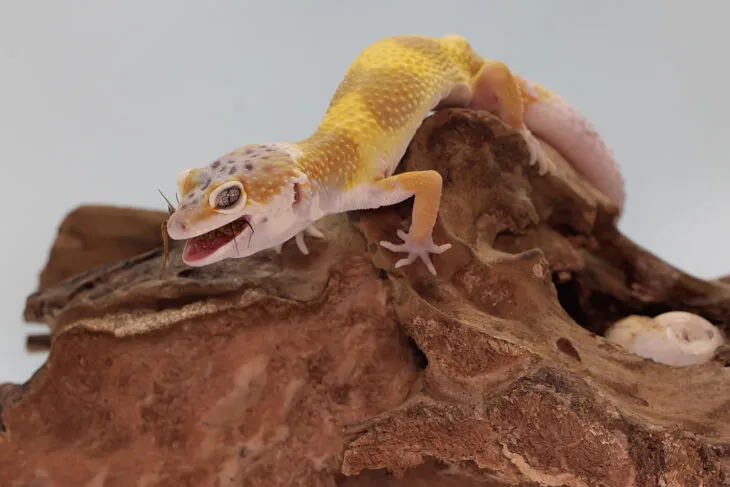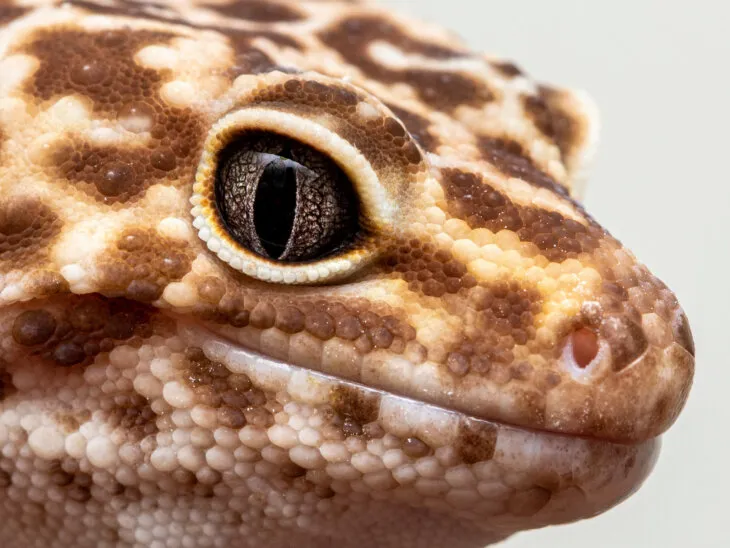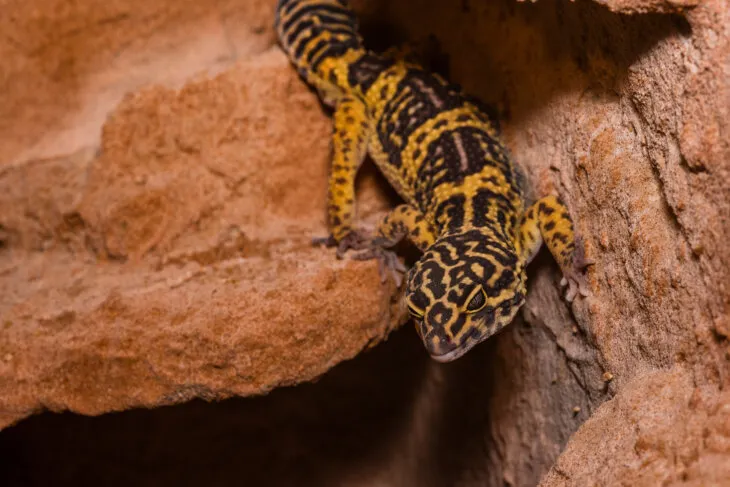
Crickets (Acheta domesticus) are a staple feeder insect that is commonly fed to Leopard Gecko (Eublepharis macularius). But, they are not good feeders if given unsupplemented or with no technique. So, how should you feed a Leopard Gecko crickets?
Crickets should be gut-loaded in the 48 hours before feeding them to a Leopard Gecko. They should usually be dusted with calcium powder. Crickets should not be left unsupervised in the
That’s a summary of the best way to prepare crickets for your Leopard Gecko. Let’s find out more about this process, as well as how many you should be feeding.
Table of Contents
Crickets Should Be Gut-Loaded
Crickets should be gut-loaded in order to improve their calcium to phosphorus ratio and to increase the vitamins and minerals that they provide.
Gut-loading means feeding the insects with healthy
Leopard Geckos need to consume a diet with a calcium to phosphorus ratio of 1:1-2:1. However, crickets have a calcium to phosphorus ratio of 1:9.
If you don’t improve their Ca:P ratio by gut-loading, your Leopard Gecko will begin to suffer from this imbalance.
As a result, his body will begin to draw the calcium it needs from his skeleton. This is called metabolic bone disease. He will become weak and deformed, and eventually begin fitting and die without medical intervention.
Gut-loading, if done well, can correct the Ca:P ratio of crickets and avoid metabolic bone disease. You can read more on the research into how effective gut-loading can be by checking out our article on why Leopard Geckos should not eat only crickets.
How To Gut Load Crickets
Crickets should be gut-loaded for 48 hours before feeding them to your Leopard Gecko. Crickets can be fed a wide range of foods as they are omnivores. Water should also be made available.
Leafy greens, carrots, apples, and bananas are all appropriate foods to provide to crickets. These foods will increase the dietary fiber value of the crickets and also provide vitamins and minerals. Feeding them also keeps them alive longer.
But, in order to improve their calcium level and to really pack them with nutrients, we advise you to feed them specially-formulated cricket feed.
Research shows that T-Rex® Calcium Plus Food™ for Crickets can effectively alter the Ca:P ratio of crickets, better than 3 other major competitors.
The commercial cricket diet of your choice will come with instructions. But, it is very easy to gut-load crickets.
Simply supply the advised amount of

Crickets Should Be Dusted With Calcium
Dusting crickets with calcium powder is another way to increase their calcium level and to provide extra vitamins and minerals. It is very important and should be done most of the time, for the reasons discussed above.
But calcium can also be given too much, leading to the mineralization of arteries and organs. Calcium can also neutralize stomach acid, making digestion less effective.
This is why adult Leopard Geckos only need to have their crickets dusted with calcium once or twice a week.
It is essential to read the instructions on any calcium or vitamin dusting powder and follow them. Consult your vet if you are unsure, to help you get supplementation right and avoid kidney damage and metabolic bone disease.
Beware Of Vitamin D Toxicity When Dusting
Dusting powders can come with or without vitamin D3. Vitamin D3 is an important nutrient as it facilitates the absorption of dietary calcium. But, it is possible to give too much vitamin D3 in the diet, resulting in toxicity. This is called hypervitaminosis D.
Water-soluble vitamins such as vitamin C and vitamin B can safely be overdosed by quite a lot. The excess vitamins are excreted in urine.
But, vitamin D (and vitamin A) are not water-soluble vitamins. These fat-soluble vitamins remain in the body and can have disastrous results such as kidney damage.
Professional and expert keepers use UVB light to enable Leopard Geckos to create their own vitamin D3 within their bodies.
It is impossible for a Leopard Gecko to suffer hypervitaminosis D from UVB light alone. Research also shows that UVB light is also more effective than dietary supplementation for raising vitamin D metabolites in the blood plasma of reptiles.
But, Leopard Geckos are crepuscular, meaning that they are active above ground at dawn and dusk; not during the strongest direct sunlight hours.
As a result, managing UVB light successfully for Leopard Geckos is extremely complex and easy to get wrong.
Therefore, we don’t recommend that most Leopard Geckos pet owners try to use UVB lamps. It is very easy to cause burns, dry skin, and eye damage.
If you are not providing your Leopard Gecko with carefully-managed UVB lighting, then you need to supplement vitamin D3.
Choose a quality product with the correct calcium to phosphorus ratio and correctly balanced vitamins. Repashy Calcium Plus is a good example, that is recommended by herp vets.
How To Dust Crickets
One method of dusting is to put some powder into a ziplock bag or container, and then place the crickets in too. Then, give it a gentle shake around to coat them. This is the most thorough method.
Another method is to place your crickets in a dish or holding container. Then simply sprinkle some powder over each one.
It is important to dust your crickets immediately before feeding. If crickets are left in the enclosure and consumed some hours after dusting, then it is likely they will not have much powder on them at all. Crickets can groom it off themselves using their legs.
Babies and juveniles should receive dusted crickets for every meal. Gravid females and Leopard Geckos who are recovering from illness should also always have dusted crickets.
This is because they are at greater risk from metabolic bone disease and require more calcium to grow tissues.
All other adults should be supplemented once or twice weekly. This means one or two of their meals will be undusted. In order to prevent over or under-supplementation, follow the instructions carefully.

How Many Crickets To Feed Your Leopard Gecko
How many crickets you need to feed your Leopard Gecko will depend on many things. These include the age and size of your pet, as well as their current health condition. For example, whether they are laying eggs, overweight, or underweight.
How many crickets you should feed also depends on what other insects you are feeding. A varied diet is important for optimum health but can make it more difficult to judge the correct amount of
The nutritional profile of crickets makes them ideal staple feeders for adult Leopard Geckos who easily put on too much weight. They have the lowest fat percentage of all the common feeder insects.
Find out more about why we think Leopard Geckos should eat crickets in our feature guide.
Adult Leopard Geckos
Adult Leopard Geckos should eat around 3 times per week, from around 10 months of age. If your adult Leopard Gecko is primarily eating crickets, a typical diet might look like this:
| Monday | 5-6 large crickets | 2-3 medium-fat larval feeder |
| Wednesday | 5-6 large crickets (dusted) | 2 wax worms (every other week) |
| Saturday | 5-6 large crickets (dusted) | 2-3 medium-fat larval feeder |
Baby And Juvenile Leopard Geckos
Baby Leopard Geckos should eat every day from 0 to 4 months of age. Between the ages of 4 months to 10 months, you should be slowly removing feeding days until they are on the adult schedule.
You should also increase the size of insects in relation to their growth.
Baby Leopard Geckos should receive 5-8 tiny crickets per day. This could be varied with medium-fat larval feeders such as hornworms or buffalo worms.
They should not receive any very high-fat treats such as wax worms, as long as they are eating and growing well.
You can learn more in our feature article on how many crickets to feed your Leopard Gecko.
Crickets Are Not Best For Babies
However, crickets are not the best feeder insect for growing Leopard Geckos. While they are high in protein, they are low in calories and have the worst calcium to phosphorus ratio.
Research shows that baby Leopard Geckos who are fed mealworms instead, grow much larger heads and tails and are longer. Mealworms have almost the same amount of protein as crickets but are a bit higher in fat.
Lesser mealworms (buffalo worms) are very similar to mealworms but come in much smaller sizes that are great for babies. Dubia roaches are also better feeders for babies.
They have the most protein of any feeder insect, as well as a medium fat content. They also have a better calcium to phosphorus ratio.
Getting the right calcium to phosphorus ratio is extremely important to baby Leopard Geckos as metabolic bone disorder is more prevalent in juveniles. Black soldier fly larvae have the best calcium to phosphorus ratio.
However, research is still ongoing as to whether Leopard Geckos can absorb the calcium from black soldier fly larvae. Also, BSF larvae could potentially cause impaction due to their high indigestible fiber level. This is not ideal for babies.
Nutritional Information For Crickets Vs Other Feeder Insects
| Crickets | Meal Worms | Dubia Roaches | Black Soldier Fly Larvae | |
| Moisture | 73% | 66% | 65% | 64% |
| Protein | 18% | 18% | 21% | 17% |
| Fat | 6% | 10% | 9% | 11% |
| Fiber | 2% | 2% | 1% | 6% |
| Ca:P Ratio | 1:9 | 1:7 | 1:3 | 2.5:1* |
(BSF Larvae Ca:P ratio: Boykin et al., 2020)
How To Deliver Crickets To Your Leopard Gecko
There are a number of different methods that owners use to deliver crickets to their Leopard Geckos.
Release The Crickets Into The Enclosure
This method of feeding is very popular. It is easy to do, and it encourages the most natural hunting scenario.
However, it also has some drawbacks. One of these is that your Leopard Gecko may get a mouthful of the substrate when eating the cricket. So, if you have a substrate such as sand, this method may not be ideal for you.
Swallowing substrate can cause impaction. Impaction occurs when indigestible substances build up in the digestive tract and block it. This is dangerous and can be fatal.
Also, it is very easy to lose the crickets in the enclosure if you put them in all at the same time. They could cause problems later when they die and rot, or nibble your pet.
This feeding method is better suited to adult Leopard Geckos, and works better under supervision.
Put The Crickets And The Leopard Gecko In A Feeding Enclosure
This method is very hygienic and functional. But, it can also be time-consuming and is less popular.
For this method, you remove our pet from their home and place them in a container that has no substrate and is washed between uses. You then place the cricket inside too.
This method allows for hunting. It prevents crickets from getting lost. And, it keeps your main enclosure cleaner.
But, it could possibly cause stress to your Leopard Gecko, as it is removed from his home. He may not eat as successfully in an unfamiliar environment.
This method is best for geckos who have been handled and moved a lot and are very confident. It is also great for messy eaters, and geckos that let their prey escape often.

Give The Cricket By Hand Or Tong Feeding
This method is excellent for building a relationship with your Leopard Gecko and working on handling and proximity. It is also good for delivering
But, it has a few drawbacks. One is that it does not allow any opportunity for hunting and enrichment. It doesn’t encourage exercise or mental stimulation.
Also, some Leopard Geckos, if fed too often by this method, may not learn how to hunt for themselves. They can become dependent on hand feeding.
Lastly, the tongs themselves can be a hazard. It is possible that your Leopard Gecko might injure their mouth if they bite the tongs over excitedly.
Also, the tongs (or hands) must be kept thoroughly clean, else they can harbor and introduce bacteria.
Give The Crickets On A Clean Surface One By One
This is our preferred method of feeding. Crickets should be placed on a clean surface in the enclosure, such as a rock or log. If you don’t have this. You can introduce a “feeding board” during feeding time.
Place one cricket down at a time, so that you can keep track of its whereabouts. Allow your Leopard Gecko to hunt it.
If it escapes the board, you can always put it back on. Don’t worry too much if your Leopard Gecko eats it from the substrate. A little won’t hurt and you’re doing your best.
The Best Feeding Technique For Babies
For baby and juvenile Leopard Geckos, the idea is to positively introduce healthy foods and get them to eat well. At first, you may need to use hand feeding or tong feeding.
Over time, you can fade this out, by dropping the insect as they get close. Eventually, they should become keener to eat and confident with catching the
If you would like to introduce a feeding enclosure, then it is best to do this from a young age, to normalize it.
Don’t Leave Loose Crickets In The Tank
It is not advisable to throw crickets in the tank and leave them there. As we mentioned above, they can rot and introduce bacteria and fungi to the habitat. Also, they may nibble on your Leopard Gecko while he is sleeping.
Find out more about how crickets can hurt Leopard Geckos in our feature article.
- Enchi Ball Python: A Unique and Stunning Morph of Python regius - March 27, 2025
- Emerald Tree Monitor: The Enigmatic Green Guardian of the Rainforest - March 26, 2025
- The Egyptian Cobra (Naja haje): A Fascinating Serpent - March 25, 2025
